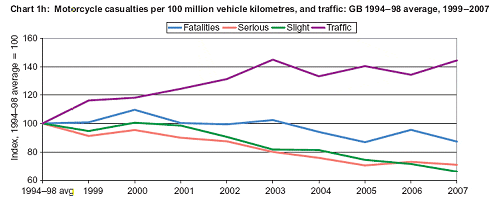
Even though more of us fell off last year, motorcycling is getting safer. Fact. Martin Gelder wades through the Department for Transport Road Casualties Report to find out what causes motorcycle accidents…
The Department for Transport’s annual report on road casualties in Great Britain came out last month. Most of the press reports at the time concentrated on the reduction in accidents involving car drivers (9% down on 2006) while pointing out that the numbers of motorcyclists “killed and seriously injured” had gone up by 4%.
Cue the usual “Ban These Killer Machines” headlines in the tabloid press. Yawn.
at they didn’t tell you is that while the number of motorcyclist’s killed of seriously injured has stayed fairly static since the government’s baseline figures set in 1994 to 1998, the amount of motorcycle traffic has gone up by 44%. So although there are slightly more of us ending up in hospital (or the morgue), there are a lot more of us out there riding our bikes.
The actual accident rate for motorcyclists fell by 6% between 2006 and 2007, and by 32% between the base line years of 1994-98 and 2007. Motorcycling is much safer than it used to be.
The 1994-98 period is important because in 2000 the government set a target of reducing the number of people killed and seriously injured on the roads by 40% in 2010, compared with the average numbers killed and seriously injured between1994 and 1998.

We’re getting there – once you take into account the increase in the amount of traffic – but we still need to make some improvements. While this is easy for car drivers and passengers (who have benefited from the widespread introduction of ABS, air bags, side impact protection bars, furry dice, etc. since 1994) we need to be a bit more scientific about how we reduce the number of accidents we have.
Fortunately, the Department for Transport’s annual report also includes information on the causes (or “contributory factors”) of accidents. This is based on forms filled in by the police at the scene of an accident, selecting up to six factors from a list of 77 possibilities. These are many and various, ranging from “aggressive driving” through “vision impaired by vegetation” to the likes of “vehicle in the course of a crime”.
For all vehicles together, the most common cause of accidents was “Failed to look properly” (35% of accidents), followed by “Failed to judge other person’s path or speed” (19%) and then “Careless, reckless or in a hurry” (17%).
There’s also a breakdown by contributory factor for accidents involving motorcycles.

“Failed to look properly” is the most common (15%) but “Loss of control”(15%) is a factor in as many motorcycle accidents. “Failed to judge other person’s path or speed” (12%) is the third most common factor, followed by “Careless, reckless or in a hurry” (10%) and “Poor turn or manoeuvre” (10%), with “Learner or inexperienced rider” a factor in 9% of accidents. “Exceeding the speed limit” (5%) is only the ninth most frequent factor of the 14 listed.
None of this should be a surprise. We’ve all heard the “Sorry mate, I didn’t see you” excuse before and most of us have probably also fallen off through no other reason than simple “loss of control”. Well, I know I have.
What did surprise me was how infrequently “exceeding the speed limit” was cited as a contributory factor. “Travelling too fast for the conditions” (7%) was a more common factor than speeding, but then I suppose it’s obvious that someone must have been travelling too fast, or there wouldn’t have been an accident.
Given the emphasis – and expense – devoted to catching and fining speeding road users, you’d think that breaking the speed limit would be one of the major causes of accidents, but in fact it’s a contributory factor in less than 1 in 20 accidents.
Seeing as two of the most common contributory factors were “Failed to look properly” and “Failed to judge other person’s path” perhaps the time has come to remove speed cameras from dangerous stretches of road, and leave us to just concentrate on what other road users are doing?
And until that happens (yeah, right) take it easy out there…
Read the full report here: www.dft.gov.uk/pgr/statistics/datatablespublications/accidents/casualtiesgbar/ roadcasualtiesgreatbritain20071




